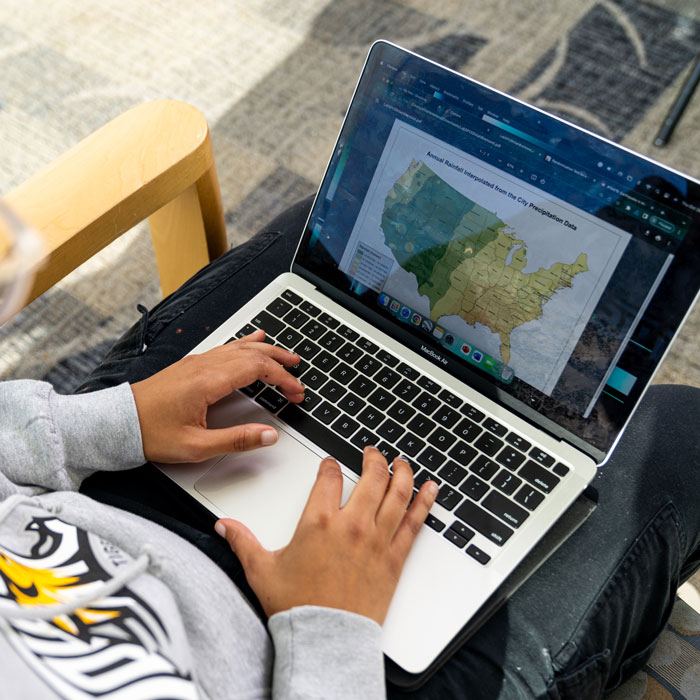Educating Maryland educators on climate change literacy
Michael Allen, PhD. shares how the Chesapeake Bay Climate Institute helps educators teach climate change
Now more than ever, it is essential for educators to understand how to teach climate literacy to students. The Chesapeake Bay Climate Institute is helping them do just that.
Through the institute, Michael Allen, assistant professor of geography in the Department of Geography and Environmental Planning, is working with the Maryland Geographic Alliance (MGA) and the Virginia Geographic Alliance to provide K-12 and post-secondary educators with experiential learning opportunities that enhance climate literacy education.
Started in 1989, the Maryland Geographic Alliance, headquartered at TU, was initially part of a state alliance networks funded by National Geographic designed to support geographic education across K-12 systems in the U.S. The alliance advocates for geographic literacy and holds geography as a key to civic engagement and global understanding in the 21st century.
Now in its fifth year, the Chesapeake Bay Climate Institute brings Maryland and Virginia educators from all disciplines and grade levels together through a multi-day summit to help them gain insight to teach climate change literacy to students.
Each summer, educators spend several days with the Virginia Institute of Marine Science (VIMS) where they hear from local watermen and guest lecturers, visit Tangier Island, and participate in discussions about what climate change is, its causes and impacts environmentally and culturally, and the possible solutions.
“Climate literacy is a natural bridge of thinking about the planet through the lens of the Chesapeake Bay; the issue of climate change connects with everything,” says Allen.
“We can see connections with climate and human experience. That’s why we have to talk about the issue of climate change using the words that people can understand and making it a human issue.”
While on Tangier Island, educators learn from local communities, including watermen, about the cultural, environmental and economic history of life on the island and how it has changed over the years.
Bridging the Gap
The Chesapeake Bay Climate Institute came to fruition because of a noticeable gap in climate literacy. At a foundational level, the most common way K-12 students are exposed to the subject of geography is through classes like AP Human Geography.
In conversations with colleague Jamie Young, Allen noticed that despite this, there was a lack of connection between the physical and social sciences of geography being made. To address this gap, Allen and Young created what is now the Chesapeake Bay Climate Institute through the Virginia Geographic Alliance.
The Chesapeake Bay watershed has a rich cultural, geographic and environmental history which made it the perfect outdoor living laboratory for the institute. It is also a hub for scientific exploration, research and experiential learning opportunities, which professors and students at TU have taken ample advantage of.
Because the institute is so interactive and hands on, Allen emphasizes that it is a sharing of knowledge among the guest speakers, watermen, and the educators.
“Many K-12 educators have never had exposure to the issue of climate change. There is an appetite for this topic, and they recognize the value of making these connections across their disciplines,” Allen says.
Student Impact at TU
Committed to the importance of educating students on climate change, Allen carries the work he does with the MGA and the Chesapeake Bay Climate Institute into the classroom every day.
In his Climate Change Science and Policy course at TU, students study climate change and its impact through an intersectional lens. Students develop policy briefs on climate science education, explore the transportation sector and the importance of reducing heat-trapping gases, and learn about human systems and the health benefits of reducing fossil fuels.
“We often think about climate change only through the lens of science, but in reality, it connects with every aspect of our world. It is embedded within history – through redlining, urban heat islands, economics, and more. If you get rid of the crab because of changing ecosystems, you change the identity of Maryland,” says Allen.
Courses like Allen’s, through the Department of Geography and Environmental Planning, enable students to explore the intersectional nature of geography and their broader implications.
“Since antiquity, geographers have contemplated the interrelationship between humans and the environment," says Charles Schmitz, chairperson of the Department of Geography and Environmental Planning, "Today, the Department of Geography prepares students to address climate change through an interdisciplinary lens that incorporates culture, politics, economics, and physical processes of the environment.”
Educating the Next Generation
At the end of the summit, educators share lessons learned and their thoughts on how they can include climate literacy in their lesson planning. In culmination, educators are challenged to share what they’ve learned with fellow attendees from grade levels different from their own to practice pedagogical approaches to explaining climate change to all grade levels.
Allen is hopeful that programs like this will become more common place, and he encourages educators of all disciplines, whether new to the field or seasoned, to take steps to becoming climate literate to better support the next generation.
"It’s valuable to invest in programs like this because, without the training of the trainer, those trainers aren’t equipped to address the challenges of tomorrow,” Allen says.
“Through experience, we’ve learned that we can merge geography and history to think about climate issues, ecology, economics, equity and public health outcomes. It’s not just a science issue; it's a human issue.”
